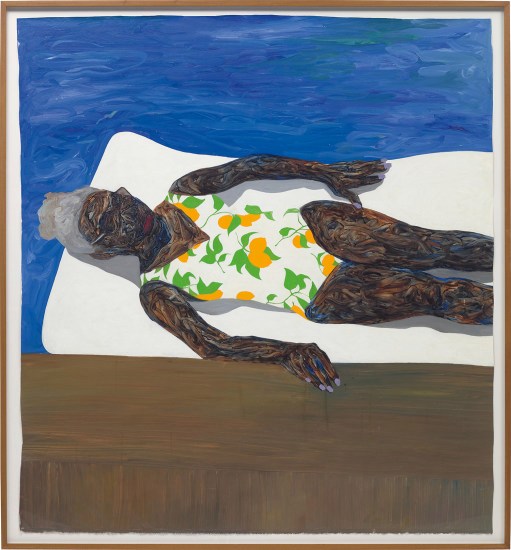[ad_1]
Phillips London evening sale of contemporary art saw a solid night of sales with an 86% sell-through rate, achieving a total of £21.2 million ($27.7 million). As with the other houses, this figure is down from the previous year’s comparable sale, which achieved £37.03 million ($48.43 million) with a smaller group of 29 lots offered last year compared to this year’s 37 lots. Four works were withdrawn before bidding began, but the well-managed and fast-paced sale saw high interest in key lots and a strong performance, with the total sale proceeds reaching slightly above pre-sale low estimate of £18.2 million (estimates do not include the buyer’s premium.)
Overall, the sale’s outcome continues this week’s trend in the contemporary art market as top prices shift to the middle-market below $5 million. This movement has various consequences. Most notably, it means houses are pressed to focus on cultivating a core market of less-seasoned collectors.
The first four lots drew aggressive protracted bidding and each reached their high estimates with interest from buyers in Hong Kong highlighted by the auctioneer. Amoako Boafo’s The Lemon Bathing Suit (2019) achieved a high price of £675,000, a major success for the one-year-old painting and the first of the artist’s works to come up at auction. It reached more than ten times its high estimate of £50,000. Los-Angeles based dealer/collector, Stefan Simchowitz, was the seller. The brash dealer is known for his aggressive trading of works by promising young artists. Several other lots that experienced strong bidding and provided the sale’s high energy were from young painters like Julie Curtiss and Eddie Martinez. Tschabalala Self, who had uncharacteristically tepid results at Christie’s and Sotheby’s this week (the works sold only slightly above estimates), saw a new record for Princess (2017.) The painting doubled its low estimate of £150,000 and sold for £435,000 ($567,501), reassuring the market that the artist’s potential remains far from fully realized.
The night’s top lots included Ed Ruscha’s God Knows Where (2014), which sold for £3.37 million ($4.4 million), landing strongly between the estimate of £2.5 to 3.5 million. The second highest lot was Keith Haring’s Untitled (1981) tarpaulin sold for £3.29 million ($4.29 million) with fees, a solid result just slightly over its £3 million low estimate.
Damien Hirst had four of seven lots in the sale from the collection of Robert Tibbles, who amassed a holding of edgy works from the Young British Artist’s movement of the 1980’s and 1990’s. Each work saw highly competitive initial interest but bidding tapered off after breaking the low estimate. Hirst’s medicine cabinet Bodies (1989) made price of £1.37 million ($1.79 million). A large dot painting, more than eight feet wide, titled Antipyrylazo III (1994) sold for £1.3 million ($1.7 million); its high estimate was £1.2 million. Hirst remains an auction staple but these works provided evidence of stronger interest in the artist than sometimes registers in the market.
Th next tier of top selling lots including Sean Scully’s Robe Green Gold (2018) and El Anatsui’s Affirmation (2014), which both sold for around $1.2M. Jai Aili’s The Young (2012) performed similarly, achieving £855,000 ($1.1 million) well above a high estimate of £600,000.
Eddie’s Martinez’s Neanderthal Jeans (2014) started with a handful of interested bidders. The final price of £375,000 ($489,150) reached slightly above its £300,000 high estimate, sustaining the artist’s success at Christie’s and Sotheby’s, still substantially below the artist’s 2014 record price of $2M.
Only a few lots failed to reach their low estimates, yet these works still saw lively opening bids. A.R. Penck, whose work set a record at the Sotheby’s Evening sale, just made the low estimate tonight with a black and white painting that sold for £200,000.
The final sale of the evening was a monochrome work by Roman Opałka, which exceeded its estimates. It sold for £471,000 ($614,419.) To create that success, Phillips had to set the estimates below a similar work sold last year at Christie’s evening sale. That work made £791,250 with fees ($973,846 USD).
The results at Phillips reflect a challenging market where much of the action has moved into private sales at galleries. This shift actually plays to Phillips’s advantage. As results thin in the top sector, attention shifts to the enduring interest in emerging artists and the value market. Phillips has long held a strong position here and its smaller drop in sales volume reflects that, in part.
[ad_2]
Source link


